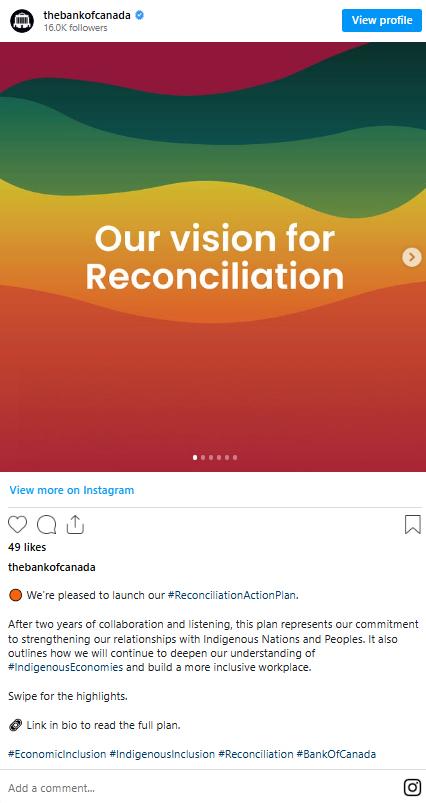
Managing the Bank
To remain a leading central bank in an era of rapid and constant change, the Bank of Canada must make continual improvements across all areas of its business. It does so in a way that is strategic, focused and driven by data. Sound management helps the Bank ensure its resources are directed where they will deliver the greatest benefit.
In 2024, these efforts enabled the Bank to be dynamic and efficient in how it achieves its business objectives and delivers on its mandate.
At all levels, decisions about the Bank’s evolution were guided by its vision, values and promise to Canadians.
Continuing to be one of the best places to work in Canada
For the 15th consecutive year, the Bank was recognized as one of Canada’s Top 100 Employers. This award reflects the Bank’s commitment to being a great place to work. In addition, the Bank was once again recognized for being among Canada’s:
- Top Family-Friendly Employers
- Best Diversity Employers
These awards are the result of the Bank’s ongoing efforts to enhance its work environment. Employees contribute to this process through a variety of formal and informal channels, including town halls, employee resource groups and surveys. The Bank also uses research on benchmarking and best practices to stay up to date on changing employee and employer needs.
Making the Bank more equitable, diverse and inclusive
The Bank implemented the 2024 priorities from its equity, diversity and inclusion strategy, and made progress on its representation goals.
An important development in this area was the launch of anti-bias training for leaders and senior officers. This is part of the Bank’s broader efforts to ensure equitable opportunities and outcomes for all employees.
Also in 2024, the Bank evolved its compensation framework to bring its practices in line with recent changes to federal pay equity legislation.
Meeting employer commitments for Reconciliation
Under its Reconciliation Action Plan, the Bank made progress on a number of commitments:
- It implemented mandatory training on Indigenous cultural awareness for all employees; this work also responds to Call to Action 57 and Call to Action 92 from the Truth and Reconciliation Commission of Canada.
- It offered workshops to help employees deepen their understanding of Reconciliation and how to be inclusive of Indigenous cultures.
- It developed an Indigenous talent strategy that includes a recruitment initiative, a hiring program and a career-development initiative.
Enhancing the Bank’s systems, tools and processes
The Bank’s operations are critical to a well-functioning Canadian economy and financial system. The Bank remained focused on enhancing its resilience and reinforcing the systems, tools and processes that enable critical operations. Focus areas included:
- updating the technology and infrastructure used at the Bank’s data centres and regional offices
- enhancing processes and strengthening compliance for third-party providers
- completing simulation exercises that tested the Bank’s ability to recover from and continue operating after a disaster
The Bank completed the migration of infrastructure and applications from its legacy environment to resilient cloud or on-site systems that increase flexibility and reliability. It continued to automate workflows and other processes, freeing up staff time for new work of greater value.
Reinforcing cyber security inside and outside the Bank
Throughout the year, cyber security threats continued to evolve rapidly. Reinforcing operational resilience against such threats remained a top priority. To this end, the Bank:
- strengthened its cyber security framework
- enhanced policies and directives to address emerging threats
- refined incident response capabilities through protocol development and readiness exercises
In addition to securing its own operations against cyber threats, the Bank also has a mandated responsibility to promote the stability and operational resilience of Canada’s financial system. To support this work, the Bank continued its leadership of the Canadian Financial Sector Resiliency Group (CFRG)—a public-private partnership focused on strengthening the financial sector’s critical infrastructure against risks to business operations, including cyber incidents.
In 2024, the CFRG completed a cross-sectoral disaster recovery exercise. It focused on assessing the risks that come from the interdependencies between the financial and telecommunications sectors.
As well, the Bank actively contributed to the G7 Cyber Expert Group. In an increasingly complex and interconnected global financial system, this working group coordinates cyber security policy and strategy across G7 jurisdictions.
Enabling data-driven decision-making
The Bank is a data-driven institution. To keep pace with changes in the data landscape and its own evolving information needs, the Bank continued to enhance its capabilities in this area.
Meeting the Bank’s commitment to greener operations
The Bank continued to look for ways to reduce the environmental impact of its operations. It began a review of the climate resilience of the buildings it owns. The review will be completed in early 2025, and will help the Bank to better forecast, manage and adapt to climate change–related impacts on its properties.
The Bank also released its 2024 report disclosing the risks it faces related to climate change. The report presents an overview of steps the Bank has taken to mitigate those risks and the progress it made on its climate commitments—including its goal of achieving net-zero greenhouse gas emissions by 2050.
Looking forward
In 2025, the Bank will:
- implement the 2025 priorities from its equity, diversity and inclusion strategy
- reinforce the resilience of its critical operations through key technology upgrades and replacements
- continue to strengthen its own cyber security posture while promoting the cyber resilience of financial systems in Canada and abroad
- continue to work toward its climate-related commitments

